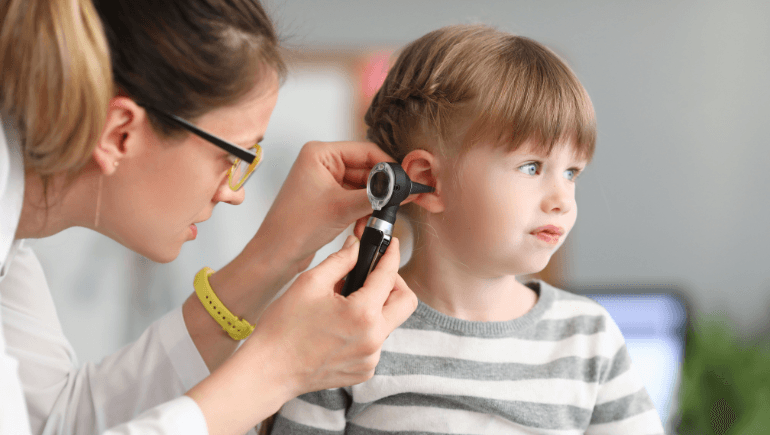Leesburg Office: (703) 215-9097
Leesburg Office: (703) 215-9097
Leesburg Office: (703) 215-9097

Pediatric Audiology
As a parent, ensuring your child's healthy development is your top priority, and hearing is an essential part of that growth. Pediatric audiology is specialized care dedicated to diagnosing and managing hearing issues in children, from three year olds through adolescence. Our compassionate team understands the unique challenges that families face when it comes to hearing health, and we are here to provide support every step of the way.

Pediatric Audiology
As a parent, ensuring your child's healthy development is your top priority, and hearing is an essential part of that growth. Pediatric audiology is specialized care dedicated to diagnosing and managing hearing issues in children, from three year olds through adolescence. Our compassionate team understands the unique challenges that families face when it comes to hearing health, and we are here to provide support every step of the way.

Pediatric Audiology
As a parent, ensuring your child's healthy development is your top priority, and hearing is an essential part of that growth. Pediatric audiology is specialized care dedicated to diagnosing and managing hearing issues in children, from three year olds through adolescence. Our compassionate team understands the unique challenges that families face when it comes to hearing health, and we are here to provide support every step of the way.

Exceptional Hearing Care for Your Little Ones
As parents ourselves, we know that nothing is more important to your family than the health of your children. That’s why we fully involve parents and guardians in the process, offering education, resources, and emotional support. Our goal is to empower you as a partner in your child's hearing health management.
A nurturing and friendly environment designed to make children feel comfortable and safe.
Highly trained professionals committed to providing the best audiological care.
A family-centered approach that emphasizes communication and collaboration at every stage.

Exceptional Hearing Care for Your Little Ones
As parents ourselves, we know that nothing is more important to your family than the health of your children. That’s why we fully involve parents and guardians in the process, offering education, resources, and emotional support. Our goal is to empower you as a partner in your child's hearing health management.
A nurturing and friendly environment designed to make children feel comfortable and safe.
Highly trained professionals committed to providing the best audiological care.
A family-centered approach that emphasizes communication and collaboration at every stage.

Exceptional Hearing Care for Your Little Ones
As parents ourselves, we know that nothing is more important to your family than the health of your children. That’s why we fully involve parents and guardians in the process, offering education, resources, and emotional support. Our goal is to empower you as a partner in your child's hearing health management.
A nurturing and friendly environment designed to make children feel comfortable and safe.
Highly trained professionals committed to providing the best audiological care.
A family-centered approach that emphasizes communication and collaboration at every stage.
Comprehensive Assessments Tailored for Children
We take a child-friendly approach to evaluate hearing, ensuring that your child is comfortable and stress-free throughout their evaluation.
Visual Reinforcement Audiometry
A fun method for kids that encourages sound localization and response through positive reinforcement.
Play Audiometry
Designed to engage young children through play, making the testing process enjoyable and stress-free.

Comprehensive Assessments Tailored for Children
We take a child-friendly approach to evaluate hearing, ensuring that your child is comfortable and stress-free throughout their evaluation.
Visual Reinforcement Audiometry
A fun method for kids that encourages sound localization and response through positive reinforcement.
Play Audiometry
Designed to engage young children through play, making the testing process enjoyable and stress-free.

Comprehensive Assessments Tailored for Children
We take a child-friendly approach to evaluate hearing, ensuring that your child is comfortable and stress-free throughout their evaluation.
Visual Reinforcement Audiometry
A fun method for kids that encourages sound localization and response through positive reinforcement.
Play Audiometry
Designed to engage young children through play, making the testing process enjoyable and stress-free.

Personalized Care Plans for Every Child
Personalized Care Plans for Every Child
Personalized Care Plans for Every Child
After assessment, our audiologists work closely with you to create a personalized care plan that meets your child’s needs. This can include:
After assessment, our audiologists work closely with you to create a personalized care plan that meets your child’s needs. This can include:
Hearing Assistance & Devices
If needed, we provide guidance on assistive hearing devices to help your child hear and understand sounds more clearly.
Hearing Assistance & Devices
If needed, we provide guidance on assistive hearing devices to help your child hear and understand sounds more clearly.
Hearing Assistance & Devices
If needed, we provide guidance on assistive hearing devices to help your child hear and understand sounds more clearly.
Auditory Therapy
Specialized therapy designed to strengthen listening skills and improve auditory processing in a fun and engaging way.
Auditory Therapy
Specialized therapy designed to strengthen listening skills and improve auditory processing in a fun and engaging way.
Auditory Therapy
Specialized therapy designed to strengthen listening skills and improve auditory processing in a fun and engaging way.
Parental Support & Strategies
We equip parents with strategies to foster healthy communication and create a supportive listening environment at home.
Parental Support & Strategies
We equip parents with strategies to foster healthy communication and create a supportive listening environment at home.
Parental Support & Strategies
We equip parents with strategies to foster healthy communication and create a supportive listening environment at home.
Our Commitment to You
By choosing us, you are partnering with a team dedicated to your quality of life and familial connections. Your journey towards enhanced hearing starts here, and we’re honored to be part of it.
Our Commitment to You
By choosing us, you are partnering with a team dedicated to your quality of life and familial connections. Your journey towards enhanced hearing starts here, and we’re honored to be part of it.
Our Commitment to You
By choosing us, you are partnering with a team dedicated to your quality of life and familial connections. Your journey towards enhanced hearing starts here, and we’re honored to be part of it.
Leesburg Office: (703) 215-9097
Leesburg Office: (703) 215-9097

